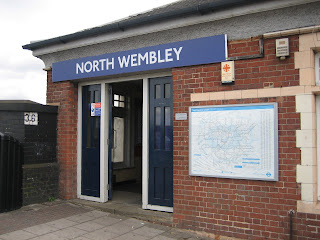As such this was a rather perfunctory trip, and also quite brisk. Baker Street to Waterloo is, of course, the route of the original line, then called the Baker Street & Waterloo Railway. The entire route opened on 10th March 1906, two years after its original financier, Whitaker Wright, committed suicide at the Royal Courts of Justice following convictions for fraud and embezzlement.
It seems it was never formally called the Bakerloo; this was just a contraction that caught the public imagination. Within a few months, however, the line had already been extended south to Elephant and Castle, so the name was technically out of date...but nobody cared.
South of Baker Street you come to Regent's Park, a station buried entirely underground with no surface buildings whatsoever and hence a very boring entrance:
To undergo complete refurbishment, the station closed soon after I begun this blog and only reopened early this year (one of the reasons I didn't get round to tackling the Bakerloo until now). You have to go a fair stretch along tunnels and down lifts to get to the platforms.
The next five stations are all old friends.
The Bakerloo entrance to Oxford Street, designed by Leslie Green, is still in good condition, despite that horrible billboard for Currency Exchange:
Green designed the Bakerloo entrance for Piccadilly Circus, which was in operation until 1929 and ripped down in the 1980s.
Charing Cross opened as Trafalgar Square in 1906, and kept that name until 1979 when the Jubilee Line prompted a complete overhaul of the stations in this area.

Embankment, meanwhile, for a long time laboured until the name Charing Cross. This photo was taken at 8.40am on a weekday morning. You can tell it's the rush hour because people have that steely, blinkered look in their eyes.
Waterloo again:
Lambeth North began life as Kennintgon Road and was the temporary southern terminus of the line until Elephant and Castle opened on 5th August 1906. It was then renamed Westminster Bridge Road, and then renamed again in April 1917 when it received its present, inferior, title. I took this photo during the station's 100th anniversary year, which explains the modest bunting:
Elephant and Castle's Leslie Green-designed station has been, to be blunt, ruined by this pointless glass extension. I can't see the reason for its existence! It looks awful, it serves no purpose, and just clutters up both the pavement and your appreciation of the original building. For shame!
There has been talk of extending the line further south, to Camberwell. I can certainly see the need for this, as it would introduce the Underground to an area of south London poorly served by public transport. As it was one of Ken Livingstone's pet projects, however, I can't see his successor giving it the time of day.




































